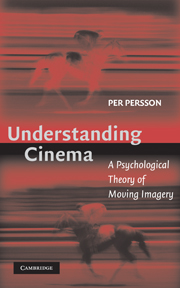Book contents
- Frontmatter
- Contents
- List of Illustrations
- Preface and Acknowledgments
- Understanding Cinema
- 1 Understanding and Dispositions
- 2 Understanding Point-of-View Editing
- 3 Variable Framing and Personal Space
- 4 Character Psychology and Mental Attribution
- 5 The Case for a Psychological Theory of Cinema
- Notes
- References
- Index
2 - Understanding Point-of-View Editing
Published online by Cambridge University Press: 15 July 2009
- Frontmatter
- Contents
- List of Illustrations
- Preface and Acknowledgments
- Understanding Cinema
- 1 Understanding and Dispositions
- 2 Understanding Point-of-View Editing
- 3 Variable Framing and Personal Space
- 4 Character Psychology and Mental Attribution
- 5 The Case for a Psychological Theory of Cinema
- Notes
- References
- Index
Summary
[W]hen we watch a movie, we take the separate spaces of the various sets and merge them into a continuous space that exists only in our minds.
(Murray, 1997:110)[E]diting is not merely a method of the junction of separate scenes or pieces, but is a method that controls the “psychological guidance” of the spectator.
Pudovkin, 1970:75If the term point-of-view (POV) is laden with multiple meanings in everyday discourse, cinema scholarship has done its best to add to this formidable semantic jungle. In narratology, the term can refer to the conceptual perspective of a character and the way knowledge is distributed by the narration among characters. It may also refer to the way in which characters comment on or relate to diegetic events. Moreover, it can designate the stance of the narrator or the implied author toward fictive events, and it can be used in reference to the filmmaker's personal POV. In all of these cases, POV is seen as a textual structure that can be investigated and revealed through meticulous textual analysis. According to one scholar,
[T]he category of point-of-view is one of the most important means of structuring narrative discourse and one of the most powerful mechanisms for audience manipulation. The manipulation of point-of-view allows the text to vary or deform the material of the fabula, presenting it from different points-of-view, restricting it to one incomplete point-of-view, or privileging a single point-of-view as hierarchically superior to others.
(Stam, Burgoyne & Flitterman-Lewis, 1992:84)The most straightforward sense of the term – which will be the only emphasis in this chapter – is perhaps optical or perceptual POV, or what I choose to call POV editing.
Information
- Type
- Chapter
- Information
- Understanding CinemaA Psychological Theory of Moving Imagery, pp. 46 - 100Publisher: Cambridge University PressPrint publication year: 2003
